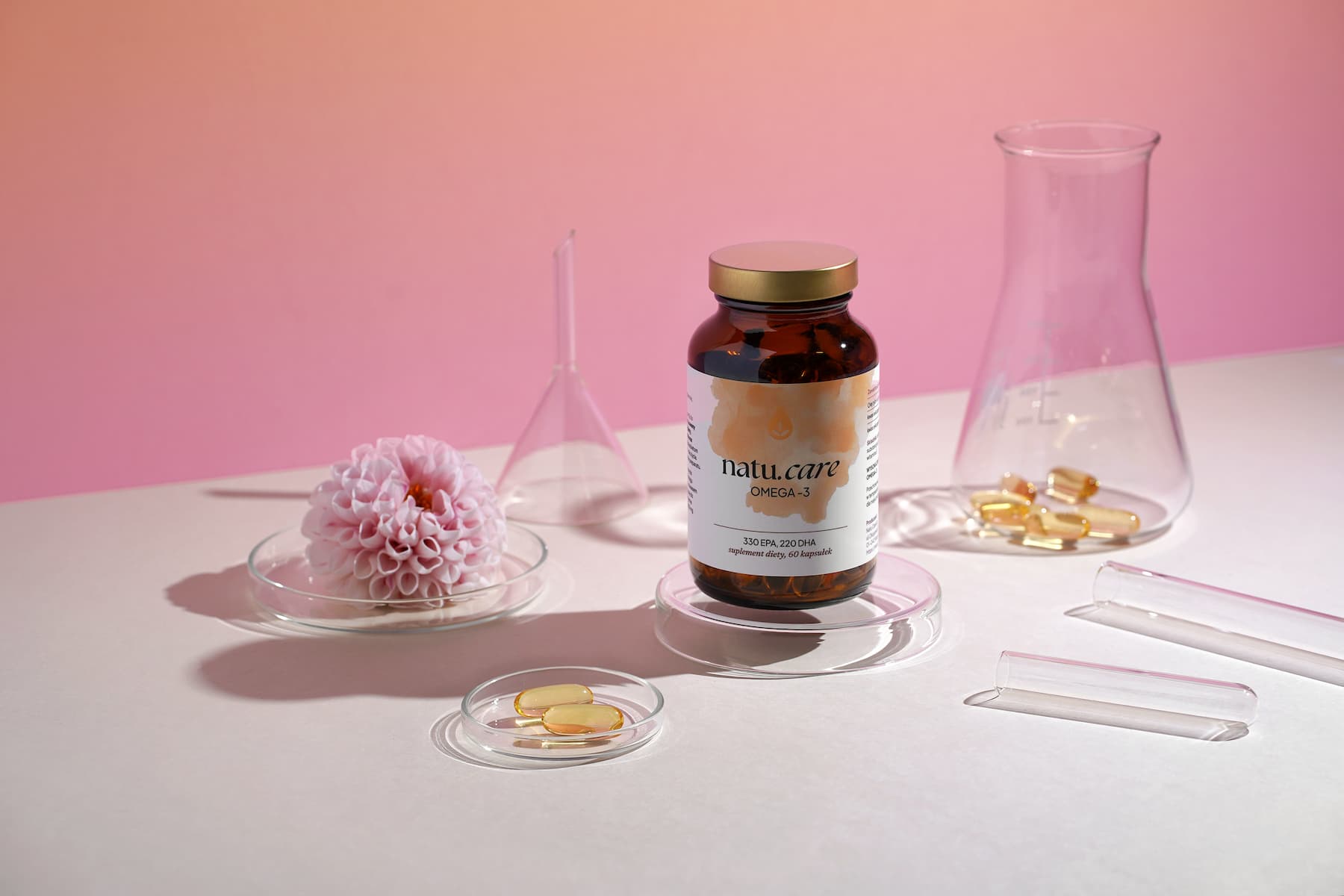- Home
- Omega acids
- Natu.Care Premium Omega-3 TG 750 mg
Natu.Care Premium Omega-3 TG 750 mg: compositional analysis and opinions
The omega-3 acids from Natu.Care are distinguished by their triglyceride form, which is characterised by high bioavailability.


Learn more about our editorial process
.

Learn more about our editorial process
.

Learn more about our editorial process
.

Learn more about our editorial process
.
Why you can trust us
Articles on Natu.Care are written based on scientific research, data from government websites and other reliable sources. The texts are written in cooperation with doctors, nutritionists and other health and beauty experts. Articles are reviewed before publication and during significant updates.
.Learn more about our editorial process
.Information about advertisements
Content on Natu.Care may contain links to products from the sale of which we may receive a commission. When creating content, we adhere to high editorial standards and take care to be objective about the products discussed. The presence of affiliate links is not dictated by our partners, and we select the products we review ourselves completely independently.
.Learn more about our terms and Conditions
.Suplement z kwasami omega-3 od Natu.Care ma wszystko to czego potrzebujesz, czyli odpowiednią porcję dzienną, wysoko przyswajalną formę trójglicerydów i świetny wynik TOTOX, który świadczy o dobrej jakości oleju z ryb.
Nasze omega-3 nie zawierają tego, czego… nie potrzebujesz – zbędnych dodatków, szkodliwych konserwantów i metali ciężkich. Brzmi jak Twój nowy suplement diety, prawda?
Z tego artykułu dowiesz się:
- Jaki skład mają kwasy omega-3 od Natu.Care.
- Jakie są wyniki badań laboratoryjnych tego suplementu.
- Jak skład ocenia magister farmacji.
- Co wyróżnia suplement Natu.Care na tle innych.
- Jak klienci oceniają kwasy omega-3.
- Dlaczego potrzebujesz kwasów omega-3 w diecie.

Sprawdź, za co pokochały go tysiące klientek Natu.Care Premium Omega-3ᵀᴳ -15% z kodem BLOG15
Natu.Care Omega-3ᵀᴳ Premium
Natu.Care Omega-3ᵀᴳ Premium dla zdrowia serca, mózgu i odporności. Najlepsza przyswajalność. Optymalna dawka 750 mg. Przebadana przez niezależne laboratorium.
Zobacz więcej
Produkt ma super skład, transparentną etykietę i co dla mnie jest ważne – małe kapsułki do połknięcia. Nie ma też nieprzyjemnego efektu odbijania rybą, który miałam spożywając inne produkty. Widzę znaczną poprawę odporności. Polecam!@Kasia P.
Zobacz też:
- Kwasy omega-3 – jakie wybrać?
- Niedobór kwasów omega-3 – objawy
- Trójglicerydy kwasów omega-3
- Kwasy omega-3
- Kwasy omega-6
- Kwasy omega-9
- Kwasy omega 3-6-9
- Kwas DHA
- Kwas EPA
- Kwas ALA
Natu.Care Premium Omega-3 TG 750 mg – analiza składu
Suplement diety z kwasami omega-3 od Natu.Care został stworzony z myślą o osobach, które chcą uzupełnić kwasy DHA i EPA w diecie. Nie oszukujmy się – nie każdemu smakują ryby (czyli najlepsze źródło omega-3), a dieta ograniczająca ich spożycie nie dostarcza EPA i DHA (tylko ALA) .
A kwasy omega-3 są Ci niezbędne – dosłownie. Musisz je dostarczać z pożywienia, ponieważ organizm ich nie wytwarza (w przeciwieństwie do np. omega-6 ). Niedobór kwasów omega-3 w Polsce jest powszechny, dlatego rozważ suplementację DHA i EPA od Natu.Care.
Zobacz też: Natu.Care Omega 550 mg
Ludzie nie mogą syntetyzować kwasów tłuszczowych omega-3, ponieważ brakuje im enzymu wytwarzającego podwójne wiązanie w kwasach tłuszczowych. Dlatego tak ważne jest dostarczanie ich z diety.

Ilona Krzak magister farmacji
Co wyróżnia Natu.Care Premium Omega-3 TG?
Forma trójglicerydów
Najpopularniejsze formy omega-3 w suplementach diety to trójglicerydy (TG) i estry etylowe (EE). Różni je budowa, proces produkcji i sposób metabolizowania w organizmie. Ponadto wiele badań naukowych wskazuje ich odmienny stopień wchłaniania do krwiobiegu – na korzyść trójglicerydów .
- W przeglądzie 18 badań naukowych wyniki 8 zdecydowanie wykazują, że forma trójglicerydów jest lepiej przyswajalna niż estry etylowe, a w 4 z nich wyniki sugerują, że ich przyswajalność jest zbliżona .
- Badania z udziałem ludzi, którzy spożywali przez 6 miesięcy kwasy omega-3 w formie TG lub EE wykazały, że wzrost stężenia omega-3 był nawet o 25% wyższy w grupie przyjmującej TG, niż u osób, które brały EE .
- Inne badania sugerują, że u badanych, którzy przez 2 tygodnie przyjmowali różne formy omega-3 średnia względna biodostępność wynosiła 76% z estrów etylowych i 134% z trójglicerydów .
Trójglicerydy kwasów omega-3 mają nawet dwukrotnie wyższą przyswajalność niż forma estrów etylowych, co oznacza, że Twój organizm przyjmie więcej DHA i EPA z suplementu z TG niż z EE .
Porcja dzienna
Omega-3 TG Premium zawiera 750 mg EPA i DHA w korzystnej proporcji 2:1. Dietetyczka kliniczna tłumaczy:
Dorosła osoba powinna wybierać suplement z wyższą zawartością EPA niż DHA. Te kwasy tłuszczowe konkurują ze sobą o przyswajanie w organizmie. EPA jest konieczny na przestrzeni całego życia, a DHA głównie w wieku niemowlęcym, dziecięcym i seniorskim.

Julia SkrajdaDietetyczka
Poziom DHA w organizmie stabilizuje się około 5. roku życia, a zapotrzebowanie na EPA jest dynamiczne i zmienne. Stosunek podaży EPA do DHA powinien wynosić 2:1 – wyjaśnia dietetyczka.
Dorosła osoba powinna spożywać minimum 250 mg EPA + DHA dziennie . To absolutne minimum, a co ciekawe, w porównaniu do innych krajów, zalecenia dla Polski wydają się być niskie. Obywatelom Brazylii, Izraela czy Stanów Zjednoczonych zaleca się przyjmowanie 1000 mg EPA+DHA dziennie .
A jeśli dodamy do tego przyswajalność, o której pisałam powyżej, stosowanie niskich porcji dziennych może być niewystarczające. Suplement z omega-3 od Natu.Care zawiera trzykrotnie większą porcję dzienną niż zalecane minimum, ale jest to bezpieczna i nieprowadząca do przedawkowania ilość.
TOTOX
TOTOX (ang. Total Oxidation) to wskaźnik, który służy do oceny stopnia utlenienia i jakości olejów rybnych. Im wyższy wynik TOTOX, tym większe ryzyko, że olej rybi jest utleniony i może mieć negatywny wpływ na jakość i skuteczność działania kwasów tłuszczowych omega-3 .
Według Europejskiego Urzędu ds. Bezpieczeństwa Żywności wskaźnik TOTOX powinien wynosić ≤ 26. Niski wynik oznacza, że olej rybny jest świeży, stabilny i ma niski poziom utlenienia, co jest korzystne dla jakości produktu .
Natu.Care Premium Omega-3 TG posiada TOTOX 9,2 – jest znacznie niższy od wymaganego ≤ 26. Są to wyniki niezależnego badania laboratorium J.S. Hamilton.
Wyniki badań sprawdzisz tutaj.
Prosty skład
Suplement Natu.Care z kwasami omega-3 nie ma zbędnych, szkodliwych dodatków takich jak sztuczne wypełniacze, barwniki czy utrwalacze. Skład jest krótki i konkretny:
- olej rybi z dzikich sardeli – świetne źródło DHA i EPA,
- żelatyna wołowa, substancja utrzymująca wilgoć: glicerol, woda – to składniki kapsułki,
- witamina E – służy jako naturalny stabilizator.
Nasz produkt dostarcza Ci tylko tego, co jest Ci potrzebne – bez niespodzianek.
Badania laboratoryjne
Natu.Care Premium Omega-3 TG zostało przebadane przez niezależne, akredytowane laboratorium J.S. Hamilton. Wyniki badań potwierdzają, że nasze kwasy omega-3 są wolne od metali ciężkich i drobnoustrojów.
Posiadanie takich badań powinno być obowiązkiem każdego producenta, szczególnie że pojawia się coraz więcej niezależnych testów produktów, które wykazują niezgodność zawartości składników aktywnych czy obecność rtęci.

Podsumowanie
Natu.Care Premium Omega-3 TG to wysokiej jakości kwasy omega-3 (DHA i EPA) w formie trójglicerydów, które są nawet dwukrotnie lepiej przyswajalne niż popularne w suplementach estry etylowe. Porcja dzienna 750 mg pokrywa 300% minimalnego zapotrzebowania na kwasy omega-3. Produkt ma czysty skład i świetny wynik TOTOX.
Jak stosować Natu.Care Premium Omega-3 TG?
Przyjmuj 1 kapsułkę dziennie i popij wodą. Stosuj o dowolnej porze dnia. Opakowanie wystarczy Ci aż na dwa miesiące suplementacji, co pomoże Ci utrzymać systematyczność – bo ona jest kluczowa. Nasz suplement możesz przyjmować bez przerwy, co szczególnie polecamy jeśli nie jadasz tłustych ryb.
Mam dla Ciebie przydatne tipy, jak wycisnąć z omega-3 więcej korzyści:
- Aby uniknąć odbijania rybą, przyjmuj kapsułkę na początku obfitego posiłku.
- Spożywaj kapsułkę w obecności zdrowych tłuszczów, ponieważ zwiększają one wchłanianie omega-3 . Zdrowe tłuszcze to: awokado, orzechy, pestki, oliwa z oliwek, jajka, soja.
- Unikaj łykania kapsułki z omega-3 z posiłkiem wysokobiałkowo-mięsnym. Białko z pokarmu może wejść w reakcję z otoczką żelatynową, co może opóźniać wchłanianie suplementu diety.
- Minimum godzinę przed przyjęciem suplementu i godzinę po – nie pij kawy, ponieważ zaburza ona wchłanianie niektórych składników odżywczych.
Dlaczego kwasy omega-3 są ważne?
Kwasy omega-3 to wielozadaniowcy – wpływają na liczne procesy i narządy w Twoim organizmie. Niedostateczna podaż kwasów omega-3 jest niebezpieczna dla zdrowia, jak i samopoczucia, a nawet… wyglądu skóry.
Na jakie obszary zdrowia wpływają kwasy omega-3?
Układ nerwowy
Kwasy omega-3 są potrzebne do budowania błon komórkowych w mózgu, co pozwala na płynny przepływ informacji między neuronami. Mogą wspomagać ich odnowę i wzrost – dzięki temu usprawnią Twoją pamięć i koncentrację .
Według badań wielonienasycone kwasy tłuszczowe mogą być pomocne w leczeniu objawów chorób neurodegeneracyjnych, np. choroby Alzheimera – poprzez hamowanie śmierci komórek mózgowych.

Marcin Zarzyckilekarz
Układ sercowo-naczyniowy
Kwasy omega-3 obniżają stężenie trójglicerydów we krwi oraz ciśnienie tętnicze. To zmniejsza ryzyko wystąpienia chorób sercowo-naczyniowych takich jak nadciśnienie, miażdżyca, choroba niedokrwienna serca i zawał serca .
Ważne
Według danych GUS w 2021 roku w Polsce najczęstszą przyczyną śmierci były choroby układu krążenia. Stanowią ponad 35% wszystkich zgonów wśród kobiet i mężczyzn.
Układ ruchu
Według badań naukowych suplementacja omega-3 zmniejsza ból u osób z chorobą zwyrodnieniową stawów maziowych oraz ogranicza ból i sztywność stawów u osób z reumatoidalnym zapaleniem stawów (RZS) .
Kwasy omega-3 zwiększają ilość wapnia w kościach, co może wzmocnić i poprawić ich strukturę . Dlatego suplementacja jest szczególnie ważna dla seniorów, którzy narażeni są na osteoporozę i większe ryzyko złamań.
Sen
Suplementacja kwasami DHA i EPA może poprawić długość i jakość snu oraz chronić przed rozwojem jego zaburzeń . Niskie stężenia omega-3 mogą prowadzić do problemów ze snem u dzieci i obturacyjnego bezdechu sennego u dorosłych .
Nadmierna senność, zmęczenie i pogorszone funkcje poznawcze obniżają jakość życia, a zła higiena snu naraża na poważne choroby – depresję, otyłość i cukrzycę.

Ilona Krzak magister farmacji
Kondycja
Kwasy tłuszczowe omega-3 mogą poprawić wyniki sportowe bezpośrednio – poprzez potencjalnie pozytywny wpływ na regenerację, siłę mięśni i wytrzymałość beztlenową oraz pośrednio, ponieważ działają ochronnie na układ nerwowy, który jest eksploatowany przez trening. Ponadto zmniejszają ryzyko kontuzji albo infekcji, które mogą wykluczyć z aktywności sportowej .
Zobacz też: Omega-3 w diecie sportowca
Stan zapalny
Przewlekły stan zapalny w organizmie może przyczynić się do rozwoju nowotworów, cukrzycy, chorób tarczycy czy zaburzeń neurodegeneracyjnych. Kwasy omega-3 mogą zmniejszyć produkcję cząsteczek i substancji związanych ze stanem zapalnym .
Osoby z chorobami autoimmunologicznymi takimi jak Hashimoto, niedoczynność i nadczynność tarczycy, reumatoidalne zapalenie stawów czy cukrzyca powinny szczególnie zwrócić uwagę na omega-3 w diecie.
Rozwój mózgu i wzroku u niemowląt
Kwasy omega-3, zwłaszcza DHA, są niezbędne do prawidłowego rozwoju siatkówki oka. Badania wykazały, że niemowlęta karmione mlekiem matki lub mlekiem modyfikowanym wzbogaconym w kwasy omega-3, mają lepszy wzrok w porównaniu z dziećmi, które ich nie otrzymywały .
Podczas ciąży kwas DHA przenika w dużych ilościach przez łożysko do płodu, gromadząc się w rozwijających się tkankach nerwowych, szczególnie podczas gwałtownego wzrostu mózgu płodu w ostatnim trymestrze ciąży.

Ilona Krzak magister farmacji
Przednie obszary mózgu są głównym obszarem akumulacji DHA i w tym czasie ulegają szybkiemu wzrostowi. Ten obszar mózgu, w szczególności kora czołowa, jest ważny dla języka, pamięci i funkcjonowania poznawczego wyższego rzędu, w tym zorientowanych na cel zachowań, które często określa się mianem funkcji wykonawczych .
Zobacz też:
Zespół metaboliczny
Zespół metaboliczny to zbiór czynników ryzyka, które występują jednocześnie i zwiększają prawdopodobieństwo rozwoju chorób sercowo-naczyniowych, cukrzycy typu 2 oraz innych poważnych problemów zdrowotnych . Odpowiednia podaż kwasów omega-3 może zmniejszać ryzyko wystąpienia tych czynników.
Zdrowie psychiczne
Badania naukowe sugerują, że odpowiednie spożycie omega-3 chroni przed depresją i zaburzeniami lękowymi . Te cenne kwasy tłuszczowe są również pomocne w leczeniu zdiagnozowanych chorób .
Metabolity wielonienasyconych kwasów tłuszczowych mogą zwiększać poziom serotoniny, której niedobór jest kluczowy w rozwoju depresji.

Marcin Zarzyckilekarz
Wzrok
Oprócz tego, że omega-3 są niezbędne do prawidłowego rozwoju siatkówki oka, to pełnią istotną funkcję prewencyjną. Mogą wpływać na lepsze ukrwienie nerwu wzrokowego oraz zmniejszać ryzyko jaskry i zwyrodnienia plamki żółtej .
Ryzyko wystąpienia chorób
Odpowiednia podaż kwasów omega-3 redukuje szanse na pojawienie się:
- Chorób autoimmunologicznych: dzięki przeciwzapalnemu działaniu kwasy omega-3 mogą zapobiegać i wspierać leczenie chorób takich jak cukrzyca, Hashimoto, stwardnienie rozsiane, reumatoidalne zapalenie stawów, łuszczyca .
- Nowotworów: według niektórych badań kwasy omega-3 mogą zapobiegać powstawaniu lub spowalniać rozwój nowotworów okrężnicy, prostaty i piersi .
Bóle menstruacyjne
Badania naukowe sugerują, że kobiety spożywające kwasy omega-3 doświadczają łagodniejszego bólu menstruacyjnego . W jednym z nich naukowcy wykazali, że suplement diety z omega-3 był skuteczniejszy w leczeniu silnego bólu podczas miesiączki niż ibuprofen .
Inne badania wykazały, że suplementacja 750 mg EPA + DHA przez 3 miesiące znacząco zmniejszyła ból brzucha, ból w dolnej części pleców i zapotrzebowanie na leki z grupy NLPZ (niesteroidowe leki przeciwzapalne) w grupie dorastających dziewcząt .
Wygląd i kondycja skóry
Kwas DHA jest składnikiem strukturalnym skóry i odpowiada za zdrowie błon komórkowych, które stanowią jej dużą część. Odpowiedni poziom tego kwasu w organizmie wspiera nawilżenie skóry i chroni ją przed przedwczesnym starzeniem .
Dieta bogata w kwasy omega-3 zmniejsza ryzyko wystąpienia trądziku i zapobiega nadmiernemu rogowaceniu mieszków włosowych, co objawia się jako małe, czerwone grudki na skórze .
Podsumowanie
Kwasy omega-3 są Ci niezbędne – wpływają na funkcjonowanie wielu układów, narządów oraz zdrowie psychiczne. Odpowiednia podaż chroni Cię przed rozwojem chorób, wspiera pracę całego organizmu i pozwala cieszyć się zdrową skórą. Omega-3 są ważne dla zdrowia przez całe życie – od etapu prenatalnego aż do seniorskiego.
Niedobór kwasów omega-3
Jeśli nie jadasz ok. 300 g tłustych ryb tygodniowo, które są najlepszym źródłem DHA i EPA w diecie, możesz być narażony na niedobór kwasów omega-3. Niestety objawy tego stanu nie są charakterystyczne, ale wymienione niżej symptomy powinny zwrócić Twoją uwagę.
Objawy niedoboru kwasów omega-3 :
- suchość skóry i oczu,
- rogowacenie naskórka,
- bóle stawów,
- obniżenie odporności,
- pogorszenie nastroju,
- zmęczenie,
- wypadanie włosów.
Jeśli doświadczasz któregoś z tych objawów, udaj się do lekarza. Pamiętaj też, aby regularnie wykonywać podstawowe badania krwi, badania hormonów tarczycy oraz potencjalne niedobory, szczególnie żelaza, witaminy B12, witaminy D i jodu.
Komu polecamy kwasy omega-3?
O kwasy omega-3 w diecie musi zadbać każdy, ale pewne grupy powinny szczególnie zwrócić uwagę na zdrowe tłuszcze w diecie:
- osoby jedzące mało tłustych ryb,
- weganie i wegetarianie,
- kobiety w ciąży i karmiące piersią,
- dzieci w okresie intensywnego wzrostu,
- seniorzy,
- pacjenci objęci leczeniem kardiologicznym i profilaktyką chorób serca,
- osoby chorujące na choroby autoimmunologiczne, np. Hashimoto, RZS,
- alergicy,
- aktywni fizycznie i sportowcy.
Przeciwwskazania do stosowania kwasów omega-3
Co wyklucza przyjmowanie kwasów omega-3 bez konsultacji z lekarzem?
- Alergie na ryby lub składniki suplementu diety z omega-3.
- Niedawna operacja lub nadchodzący zabieg chirurgiczny, gdyż kwasy omega-3 mogą zwiększyć ryzyko krwawienia.
- Dolegliwości takie jak choroba wrzodowa czy Leśniowskiego-Crohna.
- Stosowanie leków przeciwzakrzepowych lub przeciwpłytkowych.
- Zaburzenia rytmu serca.
- Ciąża.
Przed rozpoczęciem suplementacji, poradź się lekarza. On zna Twój stan zdrowia, połączy fakty, takie jak choroby czy przyjmowane leki, i zadecyduje o stosowaniu kwasów omega-3, by Twoja suplementacja była bezpieczna i skuteczna.
Kwasy omega-3 – skutki uboczne
Skutki uboczne stosowania kwasów omega-3 występują rzadko . Zazwyczaj pojawiają się w wyniku nadmiernej suplementacji i regularnego przekraczania zaleceń producenta co do porcji dziennej.
Za dużo kwasów omega-3 w organizmie objawia się :
- zmniejszeniem krzepliwości krwi,
- krwawieniami z nosa,
- biegunką, wzdęciami, odbijaniem, nudnościami, refluksem,
- podwyższeniem stężenia cukru we krwi,
- obniżeniem ciśnienia tętniczego,
- nasileniem bezsenności lub lęków.
Aby uniknąć działań niepożądanych, sprawdź przeciwwskazania do stosowania i nie przekraczaj zalecanej porcji dziennej.
Kwasy omega-3 w ciąży i podczas laktacji
Kobiety w ciąży i karmiące piersią potrzebują dziennie 250 mg kwasów EPA+DHA i dodatkowo 100–200 mg DHA . Kwasy omega-3 są ważne dla zdrowia mamy i prawidłowego rozwoju płodu .
Na opakowaniu naszego suplementu znajdziesz informację, że nie powinny go przyjmować kobiety w ciąży, a to wynika z naszej troski o bezpieczeństwo przyszłej mamy i dziecka:
- nie wiemy, czy i na co chorujesz przewlekle,
- nie wiemy jakie leki i inne suplementy diety przyjmujesz,
- nie znamy Twojego stanu zdrowia i przebiegu ciąży.
To wszystko wie lekarz i on powinien zadecydować, czy możesz bezpiecznie stosować suplement z omega-3. Ciąża to wyjątkowo wrażliwy i wymagający dla organizmu okres w życiu kobiety. Dlatego tak ważna jest konsultacja ze specjalistą.
Opinie o Natu.Care Premium Omega-3 TG 750 mg
Trójglicerydy kwasów tłuszczowych omega-3 zawarte w tym suplemencie mają znacznie wyższą biodostępność niż często spotykane w suplementach diety estry etylowe omega-3. Olej z dzikich sardeli to świetne źródło omega-3.

Ilona Krzak magister farmacji
Plus za prosty skład i dobrą porcję dzienną. Polecam każdemu, kto chce uzupełnić kwasy tłuszczowe omega-3 w diecie i stawia na wysoką jakość produktu.

Julia SkrajdaDietetyczka
Zobacz też:

Sprawdź, za co pokochały go tysiące klientek Natu.Care Premium Omega-3ᵀᴳ -15% z kodem BLOG15
Natu.Care Omega-3ᵀᴳ Premium
Natu.Care Omega-3ᵀᴳ Premium dla zdrowia serca, mózgu i odporności. Najlepsza przyswajalność. Optymalna dawka 750 mg. Przebadana przez niezależne laboratorium.
Zobacz więcej
Produkt ma super skład, transparentną etykietę i co dla mnie jest ważne – małe kapsułki do połknięcia. Nie ma też nieprzyjemnego efektu odbijania rybą, który miałam spożywając inne produkty. Widzę znaczną poprawę odporności. Polecam!@Kasia P.
Podsumowanie
- Natu.Care Premium Omega-3 TG 750 mg to suplement diety zawierający 500 mg kwasu EPA i 250 mg DHA w formie wysoko przyswajalnych trójglicerydów.
- Preparat wystarcza na 2 miesiące suplementacji, a dzienna porcja to jedna kapsułka przyjmowana o dowolnej porze dnia.
- Nasz suplement diety posiada świetny wynik TOTOX – 9,2 oraz badania laboratoryjne potwierdzające, że jest on wolny od zanieczyszczeń i drobnoustrojów.
- Skład jest krótki, prosty, bez zbędnych dodatków.
- Kwasy omega-3 są niezbędne i należy je dostarczać z diety, aby zapewnić prawidłowe funkcjonowanie wielu układów, narządów oraz zdrowia psychicznego.
- Jeśli jesteś w ciąży, chorujesz przewlekle, stosujesz leki na stałe, masz alergię lub planujesz operację, bezwzględnie skonsultuj się z lekarzem.
FAQ
Czy mogę stosować ten suplement w ciąży?
Na opakowaniu suplementu diety znajdziesz informację, że nie powinny go przyjmować kobiety w ciąży. To wynika z naszej troski o bezpieczeństwo przyszłej mamy i jej dziecka. Nie wiemy, czy i na co chorujesz przewlekle, nie wiemy jakie leki i inne suplementy diety przyjmujesz oraz nie znamy Twojego stanu zdrowia i przebiegu ciąży.
To wszystko wie lekarz i on powinien zadecydować, czy możesz bezpiecznie stosować suplement diety z kwasami omega-3.
Czy Natu.Care Omega-3 Premium TG mogę podawać dzieciom?
Kwasy omega-3 są ważne w diecie dzieci i młodzieży, szczególnie jeśli nie jedzą tłustych ryb, które są ich najlepszym źródłem. Jednak każdą suplementację dla dziecka czy nastolatka skonsultuj z lekarzem. To lekarz najlepiej wie, jaki jest stan zdrowia Twojego dziecka, jakie ma dolegliwości, choroby oraz jakie inne preparaty przyjmuje. Skład naszego suplementu jest bezpieczny, przebadany, wolny od zanieczyszczeń, jednak to lekarz powinien decydować, czy akurat Twoje dziecko potrzebuje kwasów omega-3.
Czy muszę robić przerwy w suplementacji?
Nie, nie musisz robić przerw od suplementacji. Nasz produkt możesz stosować cały rok, szczególnie jeśli nie jadasz tłustych ryb, które są najlepszym źródłem kwasów omega-3. Jeśli nie smakują Ci ryby rozważ suplementację, np. tranem smakowym.
Czy mogę stosować ten suplement na noc?
Tak, możesz przyjmować kwasy omega-3 na noc. Pora dnia, o której spożywasz suplement, nie ma znaczenia. Jest inna kwestia, na którą zwróć uwagę: spożywaj kapsułkę z pokarmem zawierającym zdrowe tłuszcze, ponieważ to zwiększa biodostępność kwasów omega-3, ułatwiając wchłanianie przez organizm.
Czy muszę suplementować omega-3 na diecie vege?
Tak, weganie i wegetarianie powinni suplementować kwasy omega-3, ponieważ:
- dieta roślinna dostarcza głównie kwasu ALA, a nie DHA i EPA,
- roślinne źródła kwasów omega-3 nie są tak dobrze przyswajalne przez organizm jak te pochodzenia zwierzęcego, a dokładniej z tłustych ryb.
Osoby na diecie roślinnej mogą wybierać suplement z omega-3 z alg morskich.
Czego unikać podczas suplementacji omega-3?
Aby suplementacja była skuteczna:
- Nie popijaj suplementu diety kawą i czarną herbatą, ponieważ te napoje zmniejszają wchłanianie niektórych składników odżywczych.
- Nie przyjmuj kapsułki na pusty żołądek – nie sprzyja to wchłanianiu i może powodować odbijanie.
- Unikaj picia alkoholu i palenia papierosów, ponieważ wypłukują one cenne kwasy omega-3 z organizmu.
- Opakowanie suplementu zamykaj szczelnie i trzymaj w suchym, chłodnym i ciemnym miejscu, aby kwasy omega-3 dłużej zachowały swoją jakość.
Dlaczego TG (trójglicerydy) są lepsze niż estry etylowe?
Kilka badań naukowych sugeruje, że forma trójglicerydów kwasów tłuszczowych omega-3 jest bardziej biodostępna i lepiej przyswajalna niż forma estrów etylowych. Oznacza to, że Twój organizm przyswoi szybciej i więcej kwasów omega-3 z suplementu z trójglicerydami niż estrami etylowymi.
Jak uniknąć odbijania rybą?
Aby uniknąć odbijania rybą, przyjmuj kapsułkę na początku obfitego posiłku, np. obiadu. Zadbaj, o obecność w posiłku zdrowych tłuszczów, są to np. awokado, orzechy, pestki i nasiona, jajka, soja.
Źródła
Zobacz wszystkie
(BIOHAZ), E. (2010). Scientific Opinion on Fish Oil for Human Consumption. Food Hygiene, including Rancidity. EFSA Journal, 8. https://doi.org/10.2903/j.efsa.2010.1874
7 Things To Know About Omega-3 Fatty Acids. (b.d.). NCCIH. Pobrano 27 listopad 2023, z https://www.nccih.nih.gov/health/tips/things-to-know-about-omega-fatty-acids
A fish a day, keeps the cardiologist away! – A review of the effect of omega-3 fatty acids in the cardiovascular system—PMC. (b.d.). Pobrano 27 listopad 2023, z https://www.ncbi.nlm.nih.gov/pmc/articles/PMC3712371/
Abd Allah, E. S. H., Gomaa, A. M. S., & Sayed, M. M. (2014). The effect of omega-3 on cognition in hypothyroid adult male rats. Acta Physiologica Hungarica, 101(3), 362–376. https://doi.org/10.1556/APhysiol.101.2014.3.11
Abdelhamid, A., Hooper, L., Sivakaran, R., Hayhoe, R. P. G., & Welch, A. A. (2019). The Relationship Between Omega-3, Omega-6 and Total Polyunsaturated Fat and Musculoskeletal Health and Functional Status in Adults: A Systematic Review and Meta-analysis of RCTs. Calcified Tissue International, 105(4). https://doi.org/10.1007/s00223-019-00584-3
Abdelnour, E., Jansen, M. O., & Gold, J. A. (2022). ADHD Diagnostic Trends: Increased Recognition or Overdiagnosis? Missouri Medicine, 119(5), 467–473.
Abdullah, M., Jowett, B., Whittaker, P. J., & Patterson, L. (2019). The effectiveness of omega-3 supplementation in reducing ADHD associated symptoms in children as measured by the Conners’ rating scales: A systematic review of randomized controlled trials. Journal of Psychiatric Research, 110, 64–73. https://doi.org/10.1016/j.jpsychires.2018.12.002
AbuMweis, S., Abu Omran, D., Al-Shami, I., & Jew, S. (2021). The ratio of eicosapentaenoic acid to docosahexaenoic acid as a modulator for the cardio-metabolic effects of omega-3 supplements: A meta-regression of randomized clinical trials. Complementary Therapies in Medicine, 57, 102662. https://doi.org/10.1016/j.ctim.2021.102662
Allam-Ndoul, B., Guénard, F., Barbier, O., & Vohl, M.-C. (2017). Effect of different concentrations of omega-3 fatty acids on stimulated THP-1 macrophages. Genes & Nutrition, 12(1), 7. https://doi.org/10.1186/s12263-017-0554-6
Amjad Khan, W., Chun-Mei, H., Khan, N., Iqbal, A., Lyu, S.-W., & Shah, F. (2017). Bioengineered Plants Can Be a Useful Source of Omega-3 Fatty Acids. BioMed Research International, 2017, 7348919. https://doi.org/10.1155/2017/7348919
An Increase in the Omega-6/Omega-3 Fatty Acid Ratio Increases the Risk for Obesity—PMC. (b.d.). Pobrano 27 listopad 2023, z https://www.ncbi.nlm.nih.gov/pmc/articles/PMC4808858/
Anderson, G. J., Connor, W. E., & Corliss, J. D. (1990). Docosahexaenoic acid is the preferred dietary n-3 fatty acid for the development of the brain and retina. Pediatric Research, 27(1), 89–97. https://doi.org/10.1203/00006450-199001000-00023
Asbaghi, O., Choghakhori, R., & Abbasnezhad, A. (2019). Effect of Omega-3 and vitamin E co-supplementation on serum lipids concentrations in overweight patients with metabolic disorders: A systematic review and meta-analysis of randomized controlled trials. Diabetes & Metabolic Syndrome: Clinical Research & Reviews, 13(4), 2525–2531. https://doi.org/10.1016/j.dsx.2019.07.001
Association between dietary omega-3 fatty acid intake and depression in postmenopausal women—PMC. (b.d.). Pobrano 27 listopad 2023, z https://www.ncbi.nlm.nih.gov/pmc/articles/PMC8313386/
Austria, J. A., Richard, M. N., Chahine, M. N., Edel, A. L., Malcolmson, L. J., Dupasquier, C. M. C., & Pierce, G. N. (2008). Bioavailability of alpha-linolenic acid in subjects after ingestion of three different forms of flaxseed. Journal of the American College of Nutrition, 27(2), 214–221. https://doi.org/10.1080/07315724.2008.10719693
Avallone, R., Vitale, G., & Bertolotti, M. (2019). Omega-3 Fatty Acids and Neurodegenerative Diseases: New Evidence in Clinical Trials. International Journal of Molecular Sciences, 20(17), 4256. https://doi.org/10.3390/ijms20174256
Backes, J., Anzalone, D., Hilleman, D., & Catini, J. (2016). The clinical relevance of omega-3 fatty acids in the management of hypertriglyceridemia. Lipids in Health and Disease, 15(1), 118. https://doi.org/10.1186/s12944-016-0286-4
Balanzá-Martínez, V., Fries, G. R., Colpo, G. D., Silveira, P. P., Portella, A. K., Tabarés-Seisdedos, R., & Kapczinski, F. (2011). Therapeutic use of omega-3 fatty acids in bipolar disorder. Expert Review of Neurotherapeutics, 11(7), 1029–1047. https://doi.org/10.1586/ern.11.42
Balbás, G. M., Regaña, M. S., & Millet, P. U. (2011). Study on the use of omega-3 fatty acids as a therapeutic supplement in treatment of psoriasis. Clinical, Cosmetic and Investigational Dermatology, 4, 73–77. https://doi.org/10.2147/CCID.S17220
Balić, A., Vlašić, D., Žužul, K., Marinović, B., & Bukvić Mokos, Z. (2020). Omega-3 Versus Omega-6 Polyunsaturated Fatty Acids in the Prevention and Treatment of Inflammatory Skin Diseases. International Journal of Molecular Sciences, 21(3), Article 3. https://doi.org/10.3390/ijms21030741
Behboudi-Gandevani, S., Hariri, F.-Z., & Moghaddam-Banaem, L. (2018). The effect of omega 3 fatty acid supplementation on premenstrual syndrome and health-related quality of life: A randomized clinical trial. Journal of Psychosomatic Obstetrics and Gynaecology, 39(4), 266–272. https://doi.org/10.1080/0167482X.2017.1348496
Boone, K. M., Klebanoff, M. A., Rogers, L. K., Rausch, J., Coury, D. L., & Keim, S. A. (2022). Effects of Omega-3-6-9 fatty acid supplementation on behavior and sleep in preterm toddlers with autism symptomatology: Secondary analysis of a randomized clinical trial. Early Human Development, 169, 105588. https://doi.org/10.1016/j.earlhumdev.2022.105588
Bozzatello, P., Brignolo, E., De Grandi, E., & Bellino, S. (2016). Supplementation with Omega-3 Fatty Acids in Psychiatric Disorders: A Review of Literature Data. Journal of Clinical Medicine, 5(8), Article 8. https://doi.org/10.3390/jcm5080067
Bradberry, J. C., & Hilleman, D. E. (2013). Overview of Omega-3 Fatty Acid Therapies. Pharmacy and Therapeutics, 38(11), 681–691.
Bryhn, M., Hansteen, H., Schanche, T., & Aakre, S. E. (2006). The bioavailability and pharmacodynamics of different concentrations of omega-3 acid ethyl esters. Prostaglandins, Leukotrienes, and Essential Fatty Acids, 75(1), 19–24. https://doi.org/10.1016/j.plefa.2006.04.003
Calder, P. C. (2010). Omega-3 Fatty Acids and Inflammatory Processes. Nutrients, 2(3), 355–374. https://doi.org/10.3390/nu2030355
Calder, P. C., Waitzberg, D. L., Klek, S., & Martindale, R. G. (2020). Lipids in Parenteral Nutrition: Biological Aspects. Journal of Parenteral and Enteral Nutrition, 44(S1), S21–S27. https://doi.org/10.1002/jpen.1756
Callaway, J., Schwab, U., Harvima, I., Halonen, P., Mykkänen, O., Hyvönen, P., & Järvinen, T. (2005). Efficacy of dietary hempseed oil in patients with atopic dermatitis. The Journal of Dermatological Treatment, 16(2), 87–94. https://doi.org/10.1080/09546630510035832
Campoy, C., Escolano-Margarit, M. V., Anjos, T., Szajewska, H., & Uauy, R. (2012). Omega 3 fatty acids on child growth, visual acuity and neurodevelopment. British Journal of Nutrition, 107(S2), S85–S106. https://doi.org/10.1017/S0007114512001493
Canhada, S., Castro, K., Perry, I. S., & Luft, V. C. (2018). Omega-3 fatty acids’ supplementation in Alzheimer’s disease: A systematic review. Nutritional Neuroscience, 21(8), 529–538. https://doi.org/10.1080/1028415X.2017.1321813
Castro Dos Santos, N. C., Furukawa, M. V., Oliveira-Cardoso, I., Cortelli, J. R., Feres, M., Van Dyke, T., & Rovai, E. S. (2022). Does the use of omega-3 fatty acids as an adjunct to non-surgical periodontal therapy provide additional benefits in the treatment of periodontitis? A systematic review and meta-analysis. Journal of Periodontal Research, 57(3), 435–447. https://doi.org/10.1111/jre.12984
Chae, M., & Park, K. (2021). Association between dietary omega-3 fatty acid intake and depression in postmenopausal women. Nutrition Research and Practice, 15(4), 468. https://doi.org/10.4162/nrp.2021.15.4.468
Chang, J. P.-C., Su, K.-P., Mondelli, V., & Pariante, C. M. (2018). Omega-3 Polyunsaturated Fatty Acids in Youths with Attention Deficit Hyperactivity Disorder: A Systematic Review and Meta-Analysis of Clinical Trials and Biological Studies. Neuropsychopharmacology, 43(3), 534–545. https://doi.org/10.1038/npp.2017.160
Chauhan, S., Kodali, H., Noor, J., Ramteke, K., & Gawai, V. (2017). Role of Omega-3 Fatty Acids on Lipid Profile in Diabetic Dyslipidaemia: Single Blind, Randomised Clinical Trial. Journal of Clinical and Diagnostic Research : JCDR, 11(3), OC13–OC16. https://doi.org/10.7860/JCDR/2017/20628.9449
Chen, B., & Dong, S. (2022). Mercury Contamination in Fish and Its Effects on the Health of Pregnant Women and Their Fetuses, and Guidance for Fish Consumption-A Narrative Review. International Journal of Environmental Research and Public Health, 19(23), 15929. https://doi.org/10.3390/ijerph192315929
Ciubotaru, I., Lee, Y.-S., & Wander, R. C. (2003). Dietary fish oil decreases C-reactive protein, interleukin-6, and triacylglycerol to HDL-cholesterol ratio in postmenopausal women on HRT. The Journal of Nutritional Biochemistry, 14(9), 513–521. https://doi.org/10.1016/s0955-2863(03)00101-3
Coletta, J. M., Bell, S. J., & Roman, A. S. (2010). Omega-3 Fatty Acids and Pregnancy. Reviews in Obstetrics and Gynecology, 3(4), 163–171.
Combarros, D., Castilla-Castaño, E., Lecru, L. A., Pressanti, C., Amalric, N., & Cadiergues, M. C. (2020). A prospective, randomized, double blind, placebo-controlled evaluation of the effects of an n-3 essential fatty acids supplement (Agepi® ω3) on clinical signs, and fatty acid concentrations in the erythrocyte membrane, hair shafts and skin surface of dogs with poor quality coats. Prostaglandins, Leukotrienes, and Essential Fatty Acids, 159, 102140. https://doi.org/10.1016/j.plefa.2020.102140
Conquer, J. A., & Holub, B. J. (1996). Supplementation with an algae source of docosahexaenoic acid increases (n-3) fatty acid status and alters selected risk factors for heart disease in vegetarian subjects. The Journal of Nutrition, 126(12), 3032–3039. https://doi.org/10.1093/jn/126.12.3032
Craddock, J. C., Probst, Y. C., Neale, E. P., & Peoples, G. E. (2022). A Cross-Sectional Comparison of the Whole Blood Fatty Acid Profile and Omega-3 Index of Male Vegan and Omnivorous Endurance Athletes. Journal of the American Nutrition Association, 41(3), 333–341. https://doi.org/10.1080/07315724.2021.1886196
Crupi, R., & Cuzzocrea, S. (2022). Role of EPA in Inflammation: Mechanisms, Effects, and Clinical Relevance. Biomolecules, 12(2), 242. https://doi.org/10.3390/biom12020242
Davidson, M. H., Johnson, J., Rooney, M. W., Kyle, M. L., & Kling, D. F. (2012). A novel omega-3 free fatty acid formulation has dramatically improved bioavailability during a low-fat diet compared with omega-3-acid ethyl esters: The ECLIPSE (Epanova(®) compared to Lovaza(®) in a pharmacokinetic single-dose evaluation) study. Journal of Clinical Lipidology, 6(6), 573–584. https://doi.org/10.1016/j.jacl.2012.01.002
Davidson, M. H., Kling, D., & Maki, K. C. (2011). Novel developments in omega-3 fatty acid-based strategies. Current Opinion in Lipidology, 22(6), 437–444. https://doi.org/10.1097/MOL.0b013e32834bd642
de Lorgeril, M., & Salen, P. (2012). New insights into the health effects of dietary saturated and omega-6 and omega-3 polyunsaturated fatty acids. BMC Medicine, 10(1), 50. https://doi.org/10.1186/1741-7015-10-50
de Wilde, M. C., Vellas, B., Girault, E., Yavuz, A. C., & Sijben, J. W. (2017). Lower brain and blood nutrient status in Alzheimer’s disease: Results from meta-analyses. Alzheimer’s & Dementia: Translational Research & Clinical Interventions, 3(3), 416–431. https://doi.org/10.1016/j.trci.2017.06.002
Derbyshire, E. (2017). Do Omega-3/6 Fatty Acids Have a Therapeutic Role in Children and Young People with ADHD? Journal of Lipids, 2017, 6285218. https://doi.org/10.1155/2017/6285218
Desbois, A. P., & Lawlor, K. C. (2013). Antibacterial Activity of Long-Chain Polyunsaturated Fatty Acids against Propionibacterium acnes and Staphylococcus aureus. Marine Drugs, 11(11), Article 11. https://doi.org/10.3390/md11114544
Deutch, B. (1995). Menstrual pain in Danish women correlated with low n-3 polyunsaturated fatty acid intake. European Journal of Clinical Nutrition, 49(7), 508–516.
Diana, F. M., & Fitria, N. (2022). Association of Omega 3 and Omega 6 and Child Development: A Systematic Review. Nutrición Clínica y Dietética Hospitalaria, 42(2), Article 2. https://doi.org/10.12873/422fivi
Dietary Omega-6/Omega-3 Polyunsaturated Fatty Acid (PUFA) and Omega-3 Are Associated With General and Abdominal Obesity in Adults: UK National Diet and Nutritional Survey—[Scite report]. (b.d.). Pobrano 27 listopad 2023, z https://scite.ai/reports/dietary-omega-6-omega-3-polyunsaturated-fatty-acid-A3rjvKNe?showReferences=true
Djuricic, I., & Calder, P. C. (2021). Beneficial Outcomes of Omega-6 and Omega-3 Polyunsaturated Fatty Acids on Human Health: An Update for 2021. Nutrients, 13(7), 2421. https://doi.org/10.3390/nu13072421
Downie, L. E., Gad, A., Wong, C. Y., Gray, J. H. V., Zeng, W., Jackson, D. C., & Vingrys, A. J. (2018). Modulating Contact Lens Discomfort With Anti-Inflammatory Approaches: A Randomized Controlled Trial. Investigative Ophthalmology & Visual Science, 59(8), 3755–3766. https://doi.org/10.1167/iovs.18-24758
Downie, L. E., & Vingrys, A. J. (2018). Oral Omega-3 Supplementation Lowers Intraocular Pressure in Normotensive Adults. Translational Vision Science & Technology, 7(3), 1. https://doi.org/10.1167/tvst.7.3.1
Dry Eye Assessment and Management Study Research Group, Asbell, P. A., Maguire, M. G., Pistilli, M., Ying, G., Szczotka-Flynn, L. B., Hardten, D. R., Lin, M. C., & Shtein, R. M. (2018). N-3 Fatty Acid Supplementation for the Treatment of Dry Eye Disease. The New England Journal of Medicine, 378(18), 1681–1690. https://doi.org/10.1056/NEJMoa1709691
Dyall, S. C. (2015). Long-chain omega-3 fatty acids and the brain: A review of the independent and shared effects of EPA, DPA and DHA. Frontiers in Aging Neuroscience, 7, 52. https://doi.org/10.3389/fnagi.2015.00052
Dyall, S. C., & Michael-Titus, A. T. (2008). Neurological Benefits of Omega-3 Fatty Acids. NeuroMolecular Medicine, 10(4), 219–235. https://doi.org/10.1007/s12017-008-8036-z
Dyerberg, J., Madsen, P., Møller, J. M., Aardestrup, I., & Schmidt, E. B. (2010). Bioavailability of marine n-3 fatty acid formulations. Prostaglandins, Leukotrienes, and Essential Fatty Acids, 83(3), 137–141. https://doi.org/10.1016/j.plefa.2010.06.007
Ebrahimi, M., Ghayour-Mobarhan, M., Rezaiean, S., Hoseini, M., Parizade, S. M. R., Farhoudi, F., Hosseininezhad, S. J., Tavallaei, S., Vejdani, A., Azimi-Nezhad, M., Shakeri, M. T., Rad, M. A., Mobarra, N., Kazemi-Bajestani, S. M. R., & Ferns, G. A. A. (2009). Omega-3 fatty acid supplements improve the cardiovascular risk profile of subjects with metabolic syndrome, including markers of inflammation and auto-immunity. Acta Cardiologica, 64(3), 321–327. https://doi.org/10.2143/AC.64.3.2038016
Effects of omega-3 polyunsaturated fatty acids on platelet function in healthy subjects and subjects with cardiovascular disease—PubMed. (b.d.). Pobrano 27 listopad 2023, z https://pubmed.ncbi.nlm.nih.gov/23329646/
EFSA assesses safety of long-chain omega-3 fatty acids | EFSA. (2012, lipiec 27). https://www.efsa.europa.eu/en/press/news/120727
EFSA Panel on Dietetic Products, Nutrition and Allergies (NDA). (2012). Scientific Opinion on the Tolerable Upper Intake Level of eicosapentaenoic acid (EPA), docosahexaenoic acid (DHA) and docosapentaenoic acid (DPA). EFSA Journal, 10(7), 2815. https://doi.org/10.2903/j.efsa.2012.2815
Elbahnasawy, A. S., Valeeva, E. R., El-Sayed, E. M., & Stepanova, N. V. (2019). Protective effect of dietary oils containing omega-3 fatty acids against glucocorticoid-induced osteoporosis. Journal of Nutrition and Health, 52(4), 323–331. https://doi.org/10.4163/jnh.2019.52.4.323
Eslick, G. D., Howe, P. R. C., Smith, C., Priest, R., & Bensoussan, A. (2009). Benefits of fish oil supplementation in hyperlipidemia: A systematic review and meta-analysis. International Journal of Cardiology, 136(1), 4–16. https://doi.org/10.1016/j.ijcard.2008.03.092
Fabian, C. J., Kimler, B. F., & Hursting, S. D. (2015). Omega-3 fatty acids for breast cancer prevention and survivorship. Breast Cancer Research, 17(1), 62. https://doi.org/10.1186/s13058-015-0571-6
Fatty Acids—An overview | ScienceDirect Topics. (b.d.). Pobrano 27 listopad 2023, z https://www.sciencedirect.com/topics/earth-and-planetary-sciences/fatty-acids
Flock, M. R., Harris, W. S., & Kris-Etherton, P. M. (2013). Long-chain omega-3 fatty acids: Time to establish a dietary reference intake. Nutrition Reviews, 71(10), 692–707. https://doi.org/10.1111/nure.12071
Fortin, P. R., Lew, R. A., Liang, M. H., Wright, E. A., Beckett, L. A., Chalmers, T. C., & Sperling, R. I. (1995). Validation of a meta-analysis: The effects of fish oil in rheumatoid arthritis. Journal of Clinical Epidemiology, 48(11), 1379–1390. https://doi.org/10.1016/0895-4356(95)00028-3
Friday, K. E., Childs, M. T., Tsunehara, C. H., Fujimoto, W. Y., Bierman, E. L., & Ensinck, J. W. (1989). Elevated plasma glucose and lowered triglyceride levels from omega-3 fatty acid supplementation in type II diabetes. Diabetes Care, 12(4), 276–281. https://doi.org/10.2337/diacare.12.4.276
Fritsche, K. L. (2015). The Science of Fatty Acids and Inflammation123. Advances in Nutrition, 6(3), 293S-301S. https://doi.org/10.3945/an.114.006940
Furman, D., Campisi, J., Verdin, E., Carrera-Bastos, P., Targ, S., Franceschi, C., Ferrucci, L., Gilroy, D. W., Fasano, A., Miller, G. W., Miller, A. H., Mantovani, A., Weyand, C. M., Barzilai, N., Goronzy, J. J., Rando, T. A., Effros, R. B., Lucia, A., Kleinstreuer, N., & Slavich, G. M. (2019). Chronic inflammation in the etiology of disease across the life span. Nature medicine, 25(12), 1822–1832. https://doi.org/10.1038/s41591-019-0675-0
Ghasemi Fard, S., Wang, F., Sinclair, A. J., Elliott, G., & Turchini, G. M. (2019). How does high DHA fish oil affect health? A systematic review of evidence. Critical Reviews in Food Science and Nutrition, 59(11), 1684–1727. https://doi.org/10.1080/10408398.2018.1425978
Goldberg, R. J., & Katz, J. (2007). A meta-analysis of the analgesic effects of omega-3 polyunsaturated fatty acid supplementation for inflammatory joint pain. Pain, 129(1–2), 210–223. https://doi.org/10.1016/j.pain.2007.01.020
González, F. E., & Báez, R. V. (2017). IN TIME: IMPORTÂNCIA DOS ÔMEGA 3 NA NUTRIÇÃO INFANTIL. Revista Paulista de Pediatria, 35, 03–04. https://doi.org/10.1590/1984-0462/;2017;35;1;00018
Greenberg, J. A., Bell, S. J., & Ausdal, W. V. (2008). Omega-3 Fatty Acid Supplementation During Pregnancy. Reviews in Obstetrics and Gynecology, 1(4), 162–169.
Grosso, G., Galvano, F., Marventano, S., Malaguarnera, M., Bucolo, C., Drago, F., & Caraci, F. (2014). Omega-3 Fatty Acids and Depression: Scientific Evidence and Biological Mechanisms. Oxidative Medicine and Cellular Longevity, 2014, 313570. https://doi.org/10.1155/2014/313570
Guesnet, P., & Alessandri, J.-M. (2011). Docosahexaenoic acid (DHA) and the developing central nervous system (CNS)—Implications for dietary recommendations. Biochimie, 93(1), 7–12. https://doi.org/10.1016/j.biochi.2010.05.005
Guo, Y., Ma, B., Li, X., Hui, H., Zhou, Y., Li, N., & Xie, X. (2022). Omega-3 Polyunsaturated Fatty Acids can Reduce IL-6 and TNF Levels in Patients with Cancer. The British Journal of Nutrition, 1–34. https://doi.org/10.1017/S0007114522000575
Gupta, R., Lakshmy, R., Abraham, R. A., Reddy, K. S., Jeemon, P., & Prabhakaran, D. (2013). Serum Omega-6/Omega-3 Ratio and Risk Markers for Cardiovascular Disease in an Industrial Population of Delhi. Food and Nutrition Sciences, 4(9), Article 9. https://doi.org/10.4236/fns.2013.49A1015
GUS. (b.d.-a). Statystyka zgonów i umieralności z powodu chorób układu krążenia. stat.gov.pl. Pobrano 27 listopad 2023, z https://stat.gov.pl/obszary-tematyczne/ludnosc/ludnosc/statystyka-zgonow-i-umieralnosci-z-powodu-chorob-ukladu-krazenia,22,1.html
GUS. (b.d.-b). Umieralność w 2021 roku. Zgony według przyczyn—Dane wstępne. stat.gov.pl. Pobrano 27 listopad 2023, z https://stat.gov.pl/obszary-tematyczne/ludnosc/statystyka-przyczyn-zgonow/umieralnosc-w-2021-roku-zgony-wedlug-przyczyn-dane-wstepne,10,3.html
Helland, I. B., Smith, L., Saarem, K., Saugstad, O. D., & Drevon, C. A. (2003). Maternal supplementation with very-long-chain n-3 fatty acids during pregnancy and lactation augments children’s IQ at 4 years of age. Pediatrics, 111(1), e39-44. https://doi.org/10.1542/peds.111.1.e39
Hidaka, B. H., Li, S., Harvey, K. E., Carlson, S. E., Sullivan, D. K., Kimler, B. F., Zalles, C. M., & Fabian, C. J. (2015). Omega-3 and Omega-6 Fatty Acids in Blood and Breast Tissue of High-Risk Women and Association with Atypical Cytomorphology. Cancer Prevention Research, 8(5), 359–364. https://doi.org/10.1158/1940-6207.CAPR-14-0351
Horrocks, L. A., & Yeo, Y. K. (1999). Health benefits of docosahexaenoic acid (DHA). Pharmacological Research, 40(3), 211–225. https://doi.org/10.1006/phrs.1999.0495
Innes, J. K., & Calder, P. C. (2018). Omega-6 fatty acids and inflammation. Prostaglandins, Leukotrienes and Essential Fatty Acids, 132, 41–48. https://doi.org/10.1016/j.plefa.2018.03.004
Innis, S. M. (2008). Dietary omega 3 fatty acids and the developing brain. Brain Research, 1237, 35–43. https://doi.org/10.1016/j.brainres.2008.08.078
Jerosch, J. (2011). Effects of Glucosamine and Chondroitin Sulfate on Cartilage Metabolism in OA: Outlook on Other Nutrient Partners Especially Omega-3 Fatty Acids. International Journal of Rheumatology, 2011, e969012. https://doi.org/10.1155/2011/969012
Jiang, H., Shi, X., Fan, Y., Wang, D., Li, B., Zhou, J., Pei, C., & Ma, L. (2021). Dietary omega-3 polyunsaturated fatty acids and fish intake and risk of age-related macular degeneration. Clinical Nutrition (Edinburgh, Scotland), 40(12), 5662–5673. https://doi.org/10.1016/j.clnu.2021.10.005
Johnson, M. (2014). Omega-3, Omega-6 and Omega-9 Fatty Acids: Implications for Cardiovascular and Other Diseases. Journal of Glycomics & Lipidomics, 04(04). https://doi.org/10.4172/2153-0637.1000123
Kangari, H., Eftekhari, M. H., Sardari, S., Hashemi, H., Salamzadeh, J., Ghassemi-Broumand, M., & Khabazkhoob, M. (2013). Short-term consumption of oral omega-3 and dry eye syndrome. Ophthalmology, 120(11), 2191–2196. https://doi.org/10.1016/j.ophtha.2013.04.006
Karcz, K., Królak-Olejnik, B., & Paluszyńska, D. (2019). [Vegetarian diet in pregnancy and lactation—Safety and rules of balancing meal plan in the aspect of optimal fetal and infant development]. Polski Merkuriusz Lekarski: Organ Polskiego Towarzystwa Lekarskiego, 46(271), 45–50.
Kavyani, Z., Musazadeh, V., Fathi, S., Hossein Faghfouri, A., Dehghan, P., & Sarmadi, B. (2022). Efficacy of the omega-3 fatty acids supplementation on inflammatory biomarkers: An umbrella meta-analysis. International Immunopharmacology, 111, 109104. https://doi.org/10.1016/j.intimp.2022.109104
Kawamura, A., Ooyama, K., Kojima, K., Kachi, H., Abe, T., Amano, K., & Aoyama, T. (2011). Dietary supplementation of gamma-linolenic acid improves skin parameters in subjects with dry skin and mild atopic dermatitis. Journal of Oleo Science, 60(12), 597–607. https://doi.org/10.5650/jos.60.597
Kendall, A. C., Kiezel-Tsugunova, M., Brownbridge, L. C., Harwood, J. L., & Nicolaou, A. (2017). Lipid functions in skin: Differential effects of n-3 polyunsaturated fatty acids on cutaneous ceramides, in a human skin organ culture model. Biochimica et Biophysica Acta (BBA) - Biomembranes, 1859(9, Part B), 1679–1689. https://doi.org/10.1016/j.bbamem.2017.03.016
Kessler, R. C., Chiu, W. T., Demler, O., Merikangas, K. R., & Walters, E. E. (2005). Prevalence, severity, and comorbidity of 12-month DSM-IV disorders in the National Comorbidity Survey Replication. Archives of General Psychiatry, 62(6), 617–627. https://doi.org/10.1001/archpsyc.62.6.617
Khalili, L., Valdes-Ramos, R., & Harbige, L. S. (2021). Effect of n-3 (Omega-3) Polyunsaturated Fatty Acid Supplementation on Metabolic and Inflammatory Biomarkers and Body Weight in Patients with Type 2 Diabetes Mellitus: A Systematic Review and Meta-Analysis of RCTs. Metabolites, 11(11), 742. https://doi.org/10.3390/metabo11110742
Kiecolt-Glaser, J. K., Belury, M. A., Andridge, R., Malarkey, W. B., & Glaser, R. (2011). Omega-3 supplementation lowers inflammation and anxiety in medical students: A randomized controlled trial. Brain, Behavior, and Immunity, 25(8), 1725–1734. https://doi.org/10.1016/j.bbi.2011.07.229
Kim, H. (2011). Glutamine as an immunonutrient. Yonsei Medical Journal, 52(6), 892–897. https://doi.org/10.3349/ymj.2011.52.6.892
Kruger, M. C., Coetzer, H., de Winter, R., Gericke, G., & van Papendorp, D. H. (1998). Calcium, gamma-linolenic acid and eicosapentaenoic acid supplementation in senile osteoporosis. Aging (Milan, Italy), 10(5), 385–394. https://doi.org/10.1007/BF03339885
Krupa, K., Fritz, K., & Parmar, M. (2023). Omega-3 Fatty Acids. W StatPearls. StatPearls Publishing. http://www.ncbi.nlm.nih.gov/books/NBK564314/
Kucukgoncu, S., Zhou, E., Lucas, K. B., & Tek, C. (2017). Alpha-Lipoic Acid (ALA) as a supplementation for weight loss: Results from a Meta-Analysis of Randomized Controlled Trials. Obesity reviews : an official journal of the International Association for the Study of Obesity, 18(5), 594–601. https://doi.org/10.1111/obr.12528
Lane, K. E., Wilson, M., Hellon, T. G., & Davies, I. G. (2022). Bioavailability and conversion of plant based sources of omega-3 fatty acids – a scoping review to update supplementation options for vegetarians and vegans. Critical Reviews in Food Science and Nutrition, 62(18), 4982–4997. https://doi.org/10.1080/10408398.2021.1880364
Lavialle, M., Champeil-Potokar, G., Alessandri, J. M., Balasse, L., Guesnet, P., Papillon, C., Pévet, P., Vancassel, S., Vivien-Roels, B., & Denis, I. (2008). An (n-3) polyunsaturated fatty acid-deficient diet disturbs daily locomotor activity, melatonin rhythm, and striatal dopamine in Syrian hamsters. The Journal of Nutrition, 138(9), 1719–1724. https://doi.org/10.1093/jn/138.9.1719
Lawson, L. D., & Hughes, B. G. (1988). Absorption of eicosapentaenoic acid and docosahexaenoic acid from fish oil triacylglycerols or fish oil ethyl esters co-ingested with a high-fat meal. Biochemical and Biophysical Research Communications, 156(2), 960–963. https://doi.org/10.1016/s0006-291x(88)80937-9
Le Floc’h, C., Cheniti, A., Connétable, S., Piccardi, N., Vincenzi, C., & Tosti, A. (2015). Effect of a nutritional supplement on hair loss in women. Journal of Cosmetic Dermatology, 14(1), 76–82. https://doi.org/10.1111/jocd.12127
Leaf, A. (2008). Historical overview of n-3 fatty acids and coronary heart disease. The American Journal of Clinical Nutrition, 87(6), 1978S-80S. https://doi.org/10.1093/ajcn/87.6.1978S
Levant, B. (2011). N-3 (Omega-3) Fatty Acids in Postpartum Depression: Implications for Prevention and Treatment. Depression Research and Treatment, 2011, 467349. https://doi.org/10.1155/2011/467349
Li, J., Xun, P., Zamora, D., Sood, A., Liu, K., Daviglus, M., Iribarren, C., Jacobs, D., Shikany, J. M., & He, K. (2013). Intakes of long-chain omega-3 (n−3) PUFAs and fish in relation to incidence of asthma among American young adults: The CARDIA study123. The American Journal of Clinical Nutrition, 97(1), 181–186. https://doi.org/10.3945/ajcn.112.041145
Li, L., & Leung, P. S. (2017). Chapter 13—Pancreatic Cancer, Pancreatitis, and Oxidative Stress. W J. Gracia-Sancho & J. Salvadó (Red.), Gastrointestinal Tissue (s. 173–186). Academic Press. https://doi.org/10.1016/B978-0-12-805377-5.00012-6
Liao, Y., Xie, B., Zhang, H., He, Q., Guo, L., Subramanieapillai, M., Fan, B., Lu, C., & McIntyre, R. S. (2019). Efficacy of omega-3 PUFAs in depression: A meta-analysis. Translational Psychiatry, 9, 190. https://doi.org/10.1038/s41398-019-0515-5
Linday, L. A. (2010). Cod Liver Oil, Young Children, and Upper Respiratory Tract Infections. Journal of the American College of Nutrition, 29(6), 559–562. https://doi.org/10.1080/07315724.2010.10719894
Liu, G., Liu, J., Pian, L., Gui, S., & Lu, B. (2019). α-lipoic acid protects against carbon tetrachloride-induced liver cirrhosis through the suppression of the TGF-β/Smad3 pathway and autophagy. Molecular Medicine Reports, 19(2), 841–850. https://doi.org/10.3892/mmr.2018.9719
Löfvenborg, J. E., Andersson, T., Carlsson, P.-O., Dorkhan, M., Groop, L., Martinell, M., Tuomi, T., Wolk, A., & Carlsson, S. (2014). Fatty fish consumption and risk of latent autoimmune diabetes in adults. Nutrition & Diabetes, 4(10), e139. https://doi.org/10.1038/nutd.2014.36
Lordan, S., Ross, R. P., & Stanton, C. (2011). Marine Bioactives as Functional Food Ingredients: Potential to Reduce the Incidence of Chronic Diseases. Marine Drugs, 9(6), 1056–1100. https://doi.org/10.3390/md9061056
Mano, Y., Kato, A., Fukuda, N., Yamada, K., & Yanagimoto, K. (2022). Influence of Ingestion of Eicosapentaenoic Acid-Rich Fish Oil on Oxidative Stress at the Menstrual Phase: A Randomized, Double-Blind, Placebo-Controlled, Parallel-Group Trial. Women’s Health Reports, 3(1), 643–651. https://doi.org/10.1089/whr.2022.0003
Marine Oils. (2006). W Drugs and Lactation Database (LactMed®). National Institute of Child Health and Human Development. http://www.ncbi.nlm.nih.gov/books/NBK501898/
Mark, B. J., Beaty, A. D., & Slavin, R. G. (2008). Are fish oil supplements safe in finned fish-allergic patients? Allergy and Asthma Proceedings, 29(5), 528–529. https://doi.org/10.2500/aap.2008.29.3159
Marklund, M., Wu, J. H. Y., Imamura, F., Del Gobbo, L. C., Fretts, A., de Goede, J., Shi, P., Tintle, N., Wennberg, M., Aslibekyan, S., Chen, T.-A., de Oliveira Otto, M. C., Hirakawa, Y., Eriksen, H. H., Kröger, J., Laguzzi, F., Lankinen, M., Murphy, R. A., Prem, K., … null, null. (2019). Biomarkers of Dietary Omega-6 Fatty Acids and Incident Cardiovascular Disease and Mortality. Circulation, 139(21), 2422–2436. https://doi.org/10.1161/CIRCULATIONAHA.118.038908
Martins, J. G. (2009). EPA but not DHA appears to be responsible for the efficacy of omega-3 long chain polyunsaturated fatty acid supplementation in depression: Evidence from a meta-analysis of randomized controlled trials. Journal of the American College of Nutrition, 28(5), 525–542. https://doi.org/10.1080/07315724.2009.10719785
McNamara, R. K. (2016). Role of Omega-3 Fatty Acids in the Etiology, Treatment, and Prevention of Depression: Current Status and Future Directions. Journal of Nutrition & Intermediary Metabolism, 5, 96–106. https://doi.org/10.1016/j.jnim.2016.04.004
Merle, B., Delyfer, M.-N., Korobelnik, J.-F., Rougier, M.-B., Colin, J., Malet, F., Féart, C., Le Goff, M., Dartigues, J.-F., Barberger-Gateau, P., & Delcourt, C. (2011). Dietary Omega-3 Fatty Acids and the Risk for Age-Related Maculopathy: The Alienor Study. Investigative Ophthalmology & Visual Science, 52(8), 6004–6011. https://doi.org/10.1167/iovs.11-7254
Merle, B. M. J., Benlian, P., Puche, N., Bassols, A., Delcourt, C., Souied, E. H., & Nutritional AMD Treatment 2 Study Group. (2014). Circulating omega-3 Fatty acids and neovascular age-related macular degeneration. Investigative Ophthalmology & Visual Science, 55(3), 2010–2019. https://doi.org/10.1167/iovs.14-13916
Mischoulon, D., & Freeman, M. P. (2013). Omega-3 fatty acids in psychiatry. The Psychiatric Clinics of North America, 36(1), 15–23. https://doi.org/10.1016/j.psc.2012.12.002
Miura, K., Vail, A., Chambers, D., Hopkins, P. M., Ferguson, L., Grant, M., Rhodes, L. E., & Green, A. C. (2019). Omega-3 fatty acid supplement skin cancer prophylaxis in lung transplant recipients: A randomized, controlled pilot trial. The Journal of Heart and Lung Transplantation, 38(1), 59–65. https://doi.org/10.1016/j.healun.2018.09.009
Moghadamnia, A. A., Mirhosseini, N., Abadi, M. H., Omranirad, A., & Omidvar, S. (2010). Effect of Clupeonella grimmi (anchovy/kilka) fish oil on dysmenorrhoea. Eastern Mediterranean Health Journal = La Revue De Sante De La Mediterranee Orientale = Al-Majallah Al-Sihhiyah Li-Sharq Al-Mutawassit, 16(4), 408–413.
Mohajeri, M. H., Troesch, B., & Weber, P. (2015). Inadequate supply of vitamins and DHA in the elderly: Implications for brain aging and Alzheimer-type dementia. Nutrition (Burbank, Los Angeles County, Calif.), 31(2), 261–275. https://doi.org/10.1016/j.nut.2014.06.016
Montgomery, P., Burton, J. R., Sewell, R. P., Spreckelsen, T. F., & Richardson, A. J. (2014). Fatty acids and sleep in UK children: Subjective and pilot objective sleep results from the DOLAB study--a randomized controlled trial. Journal of Sleep Research, 23(4), 364–388. https://doi.org/10.1111/jsr.12135
Mori, T. A. (2014). Omega-3 fatty acids and cardiovascular disease: Epidemiology and effects on cardiometabolic risk factors. Food & Function, 5(9), 2004–2019. https://doi.org/10.1039/C4FO00393D
Morris, M. C., Sacks, F., & Rosner, B. (1993). Does fish oil lower blood pressure? A meta-analysis of controlled trials. Circulation, 88(2), 523–533. https://doi.org/10.1161/01.cir.88.2.523
Naini, A. E., Keyvandarian, N., Mortazavi, M., Taheri, S., & Hosseini, S. M. (2015). Effect of Omega-3 fatty acids on blood pressure and serum lipids in continuous ambulatory peritoneal dialysis patients. Journal of Research in Pharmacy Practice, 4(3), 135–141. https://doi.org/10.4103/2279-042X.162356
Nelson, J. R., Wani, O., May, H. T., & Budoff, M. (2017). Potential benefits of eicosapentaenoic acid on atherosclerotic plaques. Vascular Pharmacology, 91, 1–9. https://doi.org/10.1016/j.vph.2017.02.004
Neubronner, J., Schuchardt, J. P., Kressel, G., Merkel, M., von Schacky, C., & Hahn, A. (2011). Enhanced increase of omega-3 index in response to long-term n-3 fatty acid supplementation from triacylglycerides versus ethyl esters. European Journal of Clinical Nutrition, 65(2), Article 2. https://doi.org/10.1038/ejcn.2010.239
Neukam, K., De Spirt, S., Stahl, W., Bejot, M., Maurette, J.-M., Tronnier, H., & Heinrich, U. (2011). Supplementation of flaxseed oil diminishes skin sensitivity and improves skin barrier function and condition. Skin Pharmacology and Physiology, 24(2), 67–74. https://doi.org/10.1159/000321442
Nevins, J. E. H., Donovan, S. M., Snetselaar, L., Dewey, K. G., Novotny, R., Stang, J., Taveras, E. M., Kleinman, R. E., Bailey, R. L., Raghavan, R., Scinto-Madonich, S. R., Venkatramanan, S., Butera, G., Terry, N., Altman, J., Adler, M., Obbagy, J. E., Stoody, E. E., & de Jesus, J. (2021). Omega-3 Fatty Acid Dietary Supplements Consumed During Pregnancy and Lactation and Child Neurodevelopment: A Systematic Review. The Journal of Nutrition, 151(11), 3483–3494. https://doi.org/10.1093/jn/nxab238
Nutrition, C. for F. S. and A. (2020). FDA Announces New Qualified Health Claims for EPA and DHA Omega-3 Consumption and the Risk of Hypertension and Coronary Heart Disease. FDA. https://www.fda.gov/food/cfsan-constituent-updates/fda-announces-new-qualified-health-claims-epa-and-dha-omega-3-consumption-and-risk-hypertension-and
Ocena narażenia konsumentów ryb na szkodliwe działanie zanieczyszczeń – Morski Instytut Rybacki – Państwowy Instytut Badawczy. (b.d.). Pobrano 1 październik 2023, z https://mir.gdynia.pl/ocena-narazenia-konsumentow-ryb-na-szkodliwe-dzialanie-zanieczyszczen/
Ochi, E., & Tsuchiya, Y. (2018). Eicosapentaenoic Acid (EPA) and Docosahexaenoic Acid (DHA) in Muscle Damage and Function. Nutrients, 10(5), 552. https://doi.org/10.3390/nu10050552
Oelrich, B., Dewell, A., & Gardner, C. D. (2013). Effect of fish oil supplementation on serum triglycerides, LDL cholesterol and LDL subfractions in hypertriglyceridemic adults. Nutrition, Metabolism, and Cardiovascular Diseases: NMCD, 23(4), 350–357. https://doi.org/10.1016/j.numecd.2011.06.003
Office of Dietary Supplements—Omega-3 Fatty Acids. (b.d.). Pobrano 27 listopad, z https://ods.od.nih.gov/factsheets/Omega3FattyAcids-Consumer/
Oliveira, J. M., & Rondó, P. H. C. (2011). Omega-3 fatty acids and hypertriglyceridemia in HIV-infected subjects on antiretroviral therapy: Systematic review and meta-analysis. HIV Clinical Trials, 12(5), 268–274. https://doi.org/10.1310/hct1205-268
Omega-3 Fatty Acids and Depression: Scientific Evidence and Biological Mechanisms. (b.d.). Pobrano 27 listopad 2023, z https://www.hindawi.com/journals/omcl/2014/313570/
Omega-3 fatty acids’ supplementation in Alzheimer’s disease: A systematic review—PubMed. (b.d.). Pobrano 27 listopad 2023, z https://pubmed.ncbi.nlm.nih.gov/28466678/
Omega-3-6-9 Fatty Acids: A Complete Overview. (2020, październik 5). Healthline. https://www.healthline.com/nutrition/omega-3-6-9-overview
Osendarp, S. J. (2011). The role of omega-3 fatty acids in child development. Oléagineux, Corps Gras, Lipides, 18(6), Article 6. https://doi.org/10.1051/ocl.2011.0417
Pahwa, R., Goyal, A., & Jialal, I. (2022). Chronic Inflammation. W StatPearls. StatPearls Publishing. http://www.ncbi.nlm.nih.gov/books/NBK493173/
Panahi, Y., Darvishi, B., Jowzi, N., Beiraghdar, F., & Sahebkar, A. (2016). Chlorella vulgaris: A Multifunctional Dietary Supplement with Diverse Medicinal Properties. Current Pharmaceutical Design, 22(2), 164–173. https://doi.org/10.2174/1381612822666151112145226
Parke, M. A., Perez-Sanchez, A., Zamil, D. H., & Katta, R. (2021). Diet and Skin Barrier: The Role of Dietary Interventions on Skin Barrier Function. Dermatology Practical & Conceptual, 11(1), e2021132. https://doi.org/10.5826/dpc.1101a132
Passi, S., Cataudella, S., Di Marco, P., De Simone, F., & Rastrelli, L. (2002). Fatty acid composition and antioxidant levels in muscle tissue of different Mediterranean marine species of fish and shellfish. Journal of Agricultural and Food Chemistry, 50(25), 7314–7322. https://doi.org/10.1021/jf020451y
Patterson, E., Wall, R., Fitzgerald, G. F., Ross, R. P., & Stanton, C. (2012). Health Implications of High Dietary Omega-6 Polyunsaturated Fatty Acids. Journal of Nutrition and Metabolism, 2012, 539426. https://doi.org/10.1155/2012/539426
Pecora, F., Persico, F., Argentiero, A., Neglia, C., & Esposito, S. (2020). The Role of Micronutrients in Support of the Immune Response against Viral Infections. Nutrients, 12(10), 3198. https://doi.org/10.3390/nu12103198
Pei-Chen Chang, J. (2021). Personalised medicine in child and Adolescent Psychiatry: Focus on omega-3 polyunsaturated fatty acids and ADHD. Brain, Behavior, & Immunity - Health, 16, 100310. https://doi.org/10.1016/j.bbih.2021.100310
Perera, H., Jeewandara, K. C., Seneviratne, S., & Guruge, C. (2012). Combined ω3 and ω6 supplementation in children with attention-deficit hyperactivity disorder (ADHD) refractory to methylphenidate treatment: A double-blind, placebo-controlled study. Journal of Child Neurology, 27(6), 747–753. https://doi.org/10.1177/0883073811435243
Peuhkuri, K., Sihvola, N., & Korpela, R. (2012). Dietary factors and fluctuating levels of melatonin. Food & Nutrition Research, 56, 10.3402/fnr.v56i0.17252. https://doi.org/10.3402/fnr.v56i0.17252
Raeder, M. B., Steen, V. M., Vollset, S. E., & Bjelland, I. (2007). Associations between cod liver oil use and symptoms of depression: The Hordaland Health Study. Journal of Affective Disorders, 101(1), 245–249. https://doi.org/10.1016/j.jad.2006.11.006
Rahul Bhargava, P. K., & Rahul Bhargava, P. K. (2013). A randomized controlled trial of omega-3 fatty acids in dry eye syndrome. International Journal of Ophthalmology, 6(6), 811–816. https://doi.org/10.3980/j.issn.2222-3959.2013.06.13
Rajaei, E., Mowla, K., Ghorbani, A., Bahadoram, S., Bahadoram, M., & Dargahi-Malamir, M. (2015). The Effect of Omega-3 Fatty Acids in Patients With Active Rheumatoid Arthritis Receiving DMARDs Therapy: Double-Blind Randomized Controlled Trial. Global Journal of Health Science, 8(7), Article 7. https://doi.org/10.5539/gjhs.v8n7p18
Ramel, A., Martinez, J. A., Kiely, M., Bandarra, N. M., & Thorsdottir, I. (2010). Moderate consumption of fatty fish reduces diastolic blood pressure in overweight and obese European young adults during energy restriction. Nutrition (Burbank, Los Angeles County, Calif.), 26(2), 168–174. https://doi.org/10.1016/j.nut.2009.04.002
Rejestr publiczny. (b.d.). Pobrano 22 wrzesień 2023, z https://powiadomienia.gis.gov.pl/
Roach, L. A., Byrne, M. K., Howard, S. J., Johnstone, S. J., Batterham, M., Wright, I. M. R., Okely, A. D., de Groot, R. H. M., van der Wurff, I. S. M., Jones, A. L., & Meyer, B. J. (2021). Effect of Omega-3 Supplementation on Self-Regulation in Typically Developing Preschool-Aged Children: Results of the Omega Kid Pilot Study—A Randomised, Double-Blind, Placebo-Controlled Trial. Nutrients, 13(10), Article 10. https://doi.org/10.3390/nu13103561
Rodriguez-Leyva, D., Bassett, C. M., McCullough, R., & Pierce, G. N. (2010). The cardiovascular effects of flaxseed and its omega-3 fatty acid, alpha-linolenic acid. The Canadian Journal of Cardiology, 26(9), 489–496.
Ross, B. M. (2007). Omega-3 fatty acid deficiency in major depressive disorder is caused by the interaction between diet and a genetically determined abnormality in phospholipid metabolism. Medical Hypotheses, 68(3), 515–524. https://doi.org/10.1016/j.mehy.2006.07.054
Rossmeisl, M., Pavlisova, J., Bardova, K., Kalendova, V., Buresova, J., Kuda, O., Kroupova, P., Stankova, B., Tvrzicka, E., Fiserova, E., Horakova, O., & Kopecky, J. (2020). Increased plasma levels of palmitoleic acid may contribute to beneficial effects of Krill oil on glucose homeostasis in dietary obese mice. Biochimica et Biophysica Acta (BBA) - Molecular and Cell Biology of Lipids, 1865(8), 158732. https://doi.org/10.1016/j.bbalip.2020.158732
Sadeghi, N., Paknezhad, F., Rashidi Nooshabadi, M., Kavianpour, M., Jafari Rad, S., & Khadem Haghighian, H. (2018). Vitamin E and fish oil, separately or in combination, on treatment of primary dysmenorrhea: A double-blind, randomized clinical trial. Gynecological Endocrinology, 34(9), 804–808. https://doi.org/10.1080/09513590.2018.1450377
SanGiovanni, J. P., & Chew, E. Y. (2005). The role of omega-3 long-chain polyunsaturated fatty acids in health and disease of the retina. Progress in Retinal and Eye Research, 24(1), 87–138. https://doi.org/10.1016/j.preteyeres.2004.06.002
Santos, H. O., May, T. L., & Bueno, A. A. (2023). Eating more sardines instead of fish oil supplementation: Beyond omega-3 polyunsaturated fatty acids, a matrix of nutrients with cardiovascular benefits. Frontiers in Nutrition, 10, 1107475. https://doi.org/10.3389/fnut.2023.1107475
Santos, H. O., Price, J. C., & Bueno, A. A. (2020). Beyond Fish Oil Supplementation: The Effects of Alternative Plant Sources of Omega-3 Polyunsaturated Fatty Acids upon Lipid Indexes and Cardiometabolic Biomarkers—An Overview. Nutrients, 12(10), Article 10. https://doi.org/10.3390/nu12103159
Sarkkinen, E. S., Savolainen, M. J., Taurio, J., Marvola, T., & Bruheim, I. (2018). Prospective, randomized, double-blinded, placebo-controlled study on safety and tolerability of the krill powder product in overweight subjects with moderately elevated blood pressure. Lipids in Health and Disease, 17(1), 287. https://doi.org/10.1186/s12944-018-0935-x
Saunders, A. V., Davis, B. C., & Garg, M. L. (2013). Omega-3 polyunsaturated fatty acids and vegetarian diets. The Medical Journal of Australia, 199(S4), S22-26. https://doi.org/10.5694/mja11.11507
Sawada, Y., Saito-Sasaki, N., & Nakamura, M. (2021). Omega 3 Fatty Acid and Skin Diseases. Frontiers in Immunology, 11, 623052. https://doi.org/10.3389/fimmu.2020.623052
Schmidt, E. B., & Dyerberg, J. (1994). Omega-3 Fatty Acids. Drugs, 47(3), 405–424. https://doi.org/10.2165/00003495-199447030-00003
Schuchardt, J. P., & Hahn, A. (2013). Bioavailability of long-chain omega-3 fatty acids. Prostaglandins, Leukotrienes, and Essential Fatty Acids, 89(1), 1–8. https://doi.org/10.1016/j.plefa.2013.03.010
Schuchardt, J. P., Huss, M., Stauss-Grabo, M., & Hahn, A. (2010). Significance of long-chain polyunsaturated fatty acids (PUFAs) for the development and behaviour of children. European Journal of Pediatrics, 169(2), 149–164. https://doi.org/10.1007/s00431-009-1035-8
Scorletti, E., & Byrne, C. D. (2013). Omega-3 Fatty Acids, Hepatic Lipid Metabolism, and Nonalcoholic Fatty Liver Disease. Annual Review of Nutrition, 33(1), 231–248. https://doi.org/10.1146/annurev-nutr-071812-161230
Sergeant, S., Rahbar, E., & Chilton, F. H. (2016). Gamma-linolenic acid, Dihommo-gamma linolenic, Eicosanoids and Inflammatory Processes. European journal of pharmacology, 785, 77–86. https://doi.org/10.1016/j.ejphar.2016.04.020
Shahidi, F., & Ambigaipalan, P. (2018). Omega-3 Polyunsaturated Fatty Acids and Their Health Benefits. Annual Review of Food Science and Technology, 9(1), 345–381. https://doi.org/10.1146/annurev-food-111317-095850
Sherzai, D., Moness, R., Sherzai, S., & Sherzai, A. (2023). A Systematic Review of Omega-3 Fatty Acid Consumption and Cognitive Outcomes in Neurodevelopment. American Journal of Lifestyle Medicine, 17(5), 649–685. https://doi.org/10.1177/15598276221116052
Simopoulos, A. P. (2002). The importance of the ratio of omega-6/omega-3 essential fatty acids. Biomedicine & Pharmacotherapy, 56(8), 365–379. https://doi.org/10.1016/S0753-3322(02)00253-6
Simopoulos, A. P. (2008). The Importance of the Omega-6/Omega-3 Fatty Acid Ratio in Cardiovascular Disease and Other Chronic Diseases. Experimental Biology and Medicine, 233(6), 674–688. https://doi.org/10.3181/0711-MR-311
Simopoulos, A. P. (2009). Evolutionary Aspects of the Dietary Omega–6:Omega–3 Fatty Acid Ratio: Medical Implications. World Review of Nutrition and Dietetics. https://doi.org/10.1159/000235706
Simopoulos, A. P. (2016). An Increase in the Omega-6/Omega-3 Fatty Acid Ratio Increases the Risk for Obesity. Nutrients, 8(3), 128. https://doi.org/10.3390/nu8030128
Simopoulos, A. P. (2020). Omega-6 and omega-3 fatty acids: Endocannabinoids, genetics and obesity. Ocl, 27. https://doi.org/10.1051/ocl/2019046
Simopoulos, A. P. (2021). Genetic Variation, Diet, Inflammation, and the Risk for COVID-19. Lifestyle Genomics, 14(2), 37–42. https://doi.org/10.1159/000513886
Singh, R. B., Dubnov, G., Niaz, M. A., Ghosh, S., Singh, R., Rastogi, S. S., Manor, O., Pella, D., & Berry, E. M. (2002). Effect of an Indo-Mediterranean diet on progression of coronary artery disease in high risk patients (Indo-Mediterranean Diet Heart Study): A randomised single-blind trial. Lancet (London, England), 360(9344), 1455–1461. https://doi.org/10.1016/S0140-6736(02)11472-3
Siscovick, D. S., Barringer, T. A., Fretts, A. M., Wu, J. H. Y., Lichtenstein, A. H., Costello, R. B., Kris-Etherton, P. M., Jacobson, T. A., Engler, M. B., Alger, H. M., Appel, L. J., Mozaffarian, D., & American Heart Association Nutrition Committee of the Council on Lifestyle and Cardiometabolic Health; Council on Epidemiology and Prevention; Council on Cardiovascular Disease in the Young; Council on Cardiovascular and Stroke Nursing; and Council on Clinical Cardiology. (2017). Omega-3 Polyunsaturated Fatty Acid (Fish Oil) Supplementation and the Prevention of Clinical Cardiovascular Disease: A Science Advisory From the American Heart Association. Circulation, 135(15), e867–e884. https://doi.org/10.1161/CIR.0000000000000482
Smith, W., McMahon, D., & Nymark, M. (2018). A Novel Combination Therapy for Patients With Dry Eye Disease: A Pilot Study. Alternative Therapies in Health and Medicine, 24(3), 12–15.
Spite, M. (2013). Deciphering the role of omega-3 polyunsaturated fatty acid-derived lipid mediators in health and disease. The Proceedings of the Nutrition Society, 72(4), 441–450. https://doi.org/10.1017/S0029665113003030
Stark, A. H., Crawford, M. A., & Reifen, R. (2008). Update on alpha-linolenic acid. Nutrition Reviews, 66(6), 326–332. https://doi.org/10.1111/j.1753-4887.2008.00040.x
Stevens, L. J., Zentall, S. S., Deck, J. L., Abate, M. L., Watkins, B. A., Lipp, S. R., & Burgess, J. R. (1995). Essential fatty acid metabolism in boys with attention-deficit hyperactivity disorder. The American Journal of Clinical Nutrition, 62(4), 761–768. https://doi.org/10.1093/ajcn/62.4.761
Strickland, A. D. (2014). Prevention of cerebral palsy, autism spectrum disorder, and attention deficit-hyperactivity disorder. Medical Hypotheses, 82(5), 522–528. https://doi.org/10.1016/j.mehy.2014.02.003
Su, K.-P., Tseng, P.-T., Lin, P.-Y., Okubo, R., Chen, T.-Y., Chen, Y.-W., & Matsuoka, Y. J. (2018). Association of Use of Omega-3 Polyunsaturated Fatty Acids With Changes in Severity of Anxiety Symptoms: A Systematic Review and Meta-analysis. JAMA Network Open, 1(5). https://doi.org/10.1001/jamanetworkopen.2018.2327
Sublette, M. E., Ellis, S. P., Geant, A. L., & Mann, J. J. (2011). Meta-analysis of the effects of eicosapentaenoic acid (EPA) in clinical trials in depression. The Journal of Clinical Psychiatry, 72(12), 1577–1584. https://doi.org/10.4088/JCP.10m06634
Surette, M. E. (2008). The science behind dietary omega-3 fatty acids. CMAJ : Canadian Medical Association Journal, 178(2), 177–180. https://doi.org/10.1503/cmaj.071356
Swanson, D., Block, R., & Mousa, S. A. (2012). Omega-3 Fatty Acids EPA and DHA: Health Benefits Throughout Life. Advances in Nutrition, 3(1), 1–7. https://doi.org/10.3945/an.111.000893
Tai, E. K. K., Wang, X. B., & Chen, Z.-Y. (2013). An update on adding docosahexaenoic acid (DHA) and arachidonic acid (AA) to baby formula. Food & Function, 4(12), 1767–1775. https://doi.org/10.1039/c3fo60298b
Tanaka, K., Farooqui, A. A., Siddiqi, N. J., Alhomida, A. S., & Ong, W.-Y. (2012). Effects of Docosahexaenoic Acid on Neurotransmission. Biomolecules & Therapeutics, 20(2), 152–157. https://doi.org/10.4062/biomolther.2012.20.2.152
Tanghetti, E. A. (2013). The Role of Inflammation in the Pathology of Acne. The Journal of Clinical and Aesthetic Dermatology, 6(9), 27–35.
Taslima, K., Al-Emran, M., Rahman, M. S., Hasan, J., Ferdous, Z., Rohani, M. F., & Shahjahan, M. (2022). Impacts of heavy metals on early development, growth and reproduction of fish—A review. Toxicology Reports, 9, 858–868. https://doi.org/10.1016/j.toxrep.2022.04.013
The top 10 causes of death. (b.d.). Pobrano 27 listopad 2023, z https://www.who.int/news-room/fact-sheets/detail/the-top-10-causes-of-death
Theodoratou, E., McNeill, G., Cetnarskyj, R., Farrington, S. M., Tenesa, A., Barnetson, R., Porteous, M., Dunlop, M., & Campbell, H. (2007). Dietary fatty acids and colorectal cancer: A case-control study. American Journal of Epidemiology, 166(2), 181–195. https://doi.org/10.1093/aje/kwm063
Thielecke, F., & Blannin, A. (2020). Omega-3 Fatty Acids for Sport Performance—Are They Equally Beneficial for Athletes and Amateurs? A Narrative Review. Nutrients, 12(12), 3712. https://doi.org/10.3390/nu12123712
Thomsen, B. J., Chow, E. Y., & Sapijaszko, M. J. (2020). The Potential Uses of Omega-3 Fatty Acids in Dermatology: A Review. Journal of Cutaneous Medicine and Surgery, 24(5), 481–494. https://doi.org/10.1177/1203475420929925
Tipton, K. D. (2015). Nutritional Support for Exercise-Induced Injuries. Sports Medicine (Auckland, N.z.), 45, 93–104. https://doi.org/10.1007/s40279-015-0398-4
Tortosa-Caparrós, E., Navas-Carrillo, D., Marín, F., & Orenes-Piñero, E. (2017). Anti-inflammatory effects of omega 3 and omega 6 polyunsaturated fatty acids in cardiovascular disease and metabolic syndrome. Critical Reviews in Food Science and Nutrition, 57(16), 3421–3429. https://doi.org/10.1080/10408398.2015.1126549
Tsitouras, P. D., Gucciardo, F., Salbe, A. D., Heward, C., & Harman, S. M. (2008). High Omega-3 Fat Intake Improves Insulin Sensitivity and Reduces CRP and IL6, but does not Affect Other Endocrine Axes in Healthy Older Adults. Hormone and Metabolic Research, 40(03), 199–205. https://doi.org/10.1055/s-2008-1046759
Vandal, M., Freemantle, E., Tremblay-Mercier, J., Plourde, M., Fortier, M., Bruneau, J., Gagnon, J., Bégin, M., & Cunnane, S. C. (2008). Plasma Omega-3 Fatty Acid Response to a Fish Oil Supplement in the Healthy Elderly. Lipids, 43(11), 1085–1089. https://doi.org/10.1007/s11745-008-3232-z
Vannice, G., & Rasmussen, H. (2014). Position of the academy of nutrition and dietetics: Dietary fatty acids for healthy adults. Journal of the Academy of Nutrition and Dietetics, 114(1), 136–153. https://doi.org/10.1016/j.jand.2013.11.001
Vermel’, A. E. (2005). [Clinical application of omega-3-fatty acids (cod-liver oil)]. Klinicheskaia Meditsina, 83(10), 51–57.
Visioli, F., Risé, P., Barassi, M. C., Marangoni, F., & Galli, C. (2003). Dietary intake of fish vs. Formulations leads to higher plasma concentrations of n-3 fatty acids. Lipids, 38(4), 415–418. https://doi.org/10.1007/s11745-003-1077-x
von Schacky, C. (2006). A review of omega-3 ethyl esters for cardiovascular prevention and treatment of increased blood triglyceride levels. Vascular Health and Risk Management, 2(3), 251–262. https://doi.org/10.2147/vhrm.2006.2.3.251
von Schacky, C. (2014). Omega-3 index and cardiovascular health. Nutrients, 6(2), 799–814. https://doi.org/10.3390/nu6020799
Walker, R. E., Jackson, K. H., Tintle, N. L., Shearer, G. C., Bernasconi, A., Masson, S., Latini, R., Heydari, B., Kwong, R. Y., Flock, M., Kris-Etherton, P. M., Hedengran, A., Carney, R. M., Skulas-Ray, A., Gidding, S. S., Dewell, A., Gardner, C. D., Grenon, S. M., Sarter, B., … Harris, W. S. (2019). Predicting the effects of supplemental EPA and DHA on the omega-3 index. The American Journal of Clinical Nutrition, 110(4), 1034–1040. https://doi.org/10.1093/ajcn/nqz161
Wang, C., Harris, W. S., Chung, M., Lichtenstein, A. H., Balk, E. M., Kupelnick, B., Jordan, H. S., & Lau, J. (2006). n-3 Fatty acids from fish or fish-oil supplements, but not alpha-linolenic acid, benefit cardiovascular disease outcomes in primary- and secondary-prevention studies: A systematic review. The American Journal of Clinical Nutrition, 84(1), 5–17. https://doi.org/10.1093/ajcn/84.1.5
Wani, A. L., Bhat, S. A., & Ara, A. (2015). Omega-3 fatty acids and the treatment of depression: A review of scientific evidence. Integrative Medicine Research, 4(3), 132–141. https://doi.org/10.1016/j.imr.2015.07.003
Watanabe, F., Yabuta, Y., Bito, T., & Teng, F. (2014). Vitamin B12-Containing Plant Food Sources for Vegetarians. Nutrients, 6(5), 1861–1873. https://doi.org/10.3390/nu6051861
Wells, M. L., Potin, P., Craigie, J. S., Raven, J. A., Merchant, S. S., Helliwell, K. E., Smith, A. G., Camire, M. E., & Brawley, S. H. (2017). Algae as nutritional and functional food sources: Revisiting our understanding. Journal of Applied Phycology, 29(2), 949–982. https://doi.org/10.1007/s10811-016-0974-5
Why not flaxseed oil? (2006, październik 1). Harvard Health. https://www.health.harvard.edu/heart-health/why-not-flaxseed-oil
Wooten, J. S., Biggerstaff, K. D., & Ben-Ezra, V. (2009). Responses of LDL and HDL particle size and distribution to omega-3 fatty acid supplementation and aerobic exercise. Journal of Applied Physiology, 107(3), 794–800. https://doi.org/10.1152/japplphysiol.91062.2008
Woźniak, D., Przysławski, J., Banaszak, M., & Drzymała-Czyż, S. (2022). Dietary Supplements among Children Ages 0-3 Years in Poland-Are They Necessary? Foods (Basel, Switzerland), 12(1), 16. https://doi.org/10.3390/foods12010016
Xie, D., Jackson, E. N., & Zhu, Q. (2015). Sustainable source of omega-3 eicosapentaenoic acid from metabolically engineered Yarrowia lipolytica: From fundamental research to commercial production. Applied Microbiology and Biotechnology, 99(4), 1599–1610. https://doi.org/10.1007/s00253-014-6318-y
Yashodhara, B. M., Umakanth, S., Pappachan, J. M., Bhat, S. K., Kamath, R., & Choo, B. H. (2009). Omega-3 fatty acids: A comprehensive review of their role in health and disease. Postgraduate Medical Journal, 85(1000), 84–90. https://doi.org/10.1136/pgmj.2008.073338
Yelland, L. N., Gajewski, B. J., Colombo, J., Gibson, R. A., Makrides, M., & Carlson, S. E. (2016). Predicting the effect of maternal docosahexaenoic acid (DHA) supplementation to reduce early preterm birth in Australia and the United States using results of within country randomized controlled trials. Prostaglandins, Leukotrienes, and Essential Fatty Acids, 112, 44–49. https://doi.org/10.1016/j.plefa.2016.08.007
Zafari, M., Behmanesh, F., & Agha Mohammadi, A. (2011). Comparison of the effect of fish oil and ibuprofen on treatment of severe pain in primary dysmenorrhea. Caspian Journal of Internal Medicine, 2(3), 279–282.
Zaouali-Ajina, M., Gharib, A., Durand, G., Gazzah, N., Claustrat, B., Gharib, C., & Sarda, N. (1999). Dietary docosahexaenoic acid-enriched phospholipids normalize urinary melatonin excretion in adult (n-3) polyunsaturated fatty acid-deficient rats. The Journal of Nutrition, 129(11), 2074–2080. https://doi.org/10.1093/jn/129.11.2074
Zhang, A. C., Singh, S., Craig, J. P., & Downie, L. E. (2020). Omega-3 Fatty Acids and Eye Health: Opinions and Self-Reported Practice Behaviors of Optometrists in Australia and New Zealand. Nutrients, 12(4), 1179. https://doi.org/10.3390/nu12041179
Editorials
Meet the team

Ilona Krzak obtained her Master of Pharmacy degree from the Medical University of Wrocław. She did her internship in a hospital pharmacy and in the pharmaceutical industry. She is currently working in the profession and also runs an educational profile on Instagram: @pani_z_apteki


Omega-3 fatty acids are a useful dietary supplement for active people - improves performance and fitness.

Omega-3 in a good dose and an optimum ratio of DHA and EPA acids will replenish valuable fats in the diet.

The EPA and DHA duo is extremely important for your body. Are you taking care of their amount in your diet?
